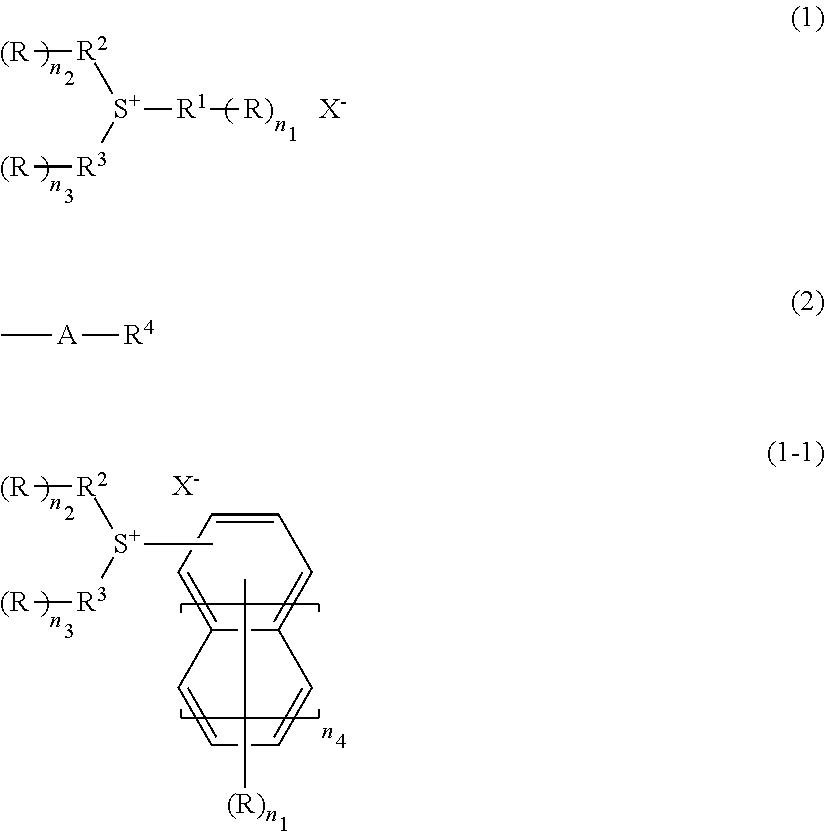Radiation-sensitive resin composition, method for forming a resist pattern and sulfonium compound
a technology of sulfonium compound and resin composition, which is applied in the direction of photosensitive materials, instruments, photomechanical apparatuses, etc., can solve the problems of microfabrication at a level no greater than 0.10 m (sub-quarter micron level) that is extremely difficult to carry out, and the depth of focus decreases
- Summary
- Abstract
- Description
- Claims
- Application Information
AI Technical Summary
Benefits of technology
Problems solved by technology
Method used
Image
Examples
synthesis example 1
Synthesis of Precursor
[0199](A) As a precursor of a sulfonyl compound, a compound represented by the following formula (a1), diphenyl(4-(3,3,3-trifluoropropanoyloxy)phenyl)sulfonium chloride was synthesized by a method as shown below.
[0200]Into a flask, a mixture of 31.5 g of (4-hydroxyphenyl)diphenylsulfonium chloride, 115 g of trifluoromethyl acetic acid anhydride, and 100 mL of trifluoroacetic acid was added and the mixture was stirred under nitrogen at room temperature for 4 hrs. Trifluoroacetic acid was removed in vacuo, and then 1,000 mL of ethyl acetate was added. Reaction liquid that was washed three times with 1,000 mL of water was concentrated in vacuo to obtain 42.1 g of diphenyl(4-(3,3,3-trifluoropropanoyloxy)phenyl)sulfonium chloride.
[0201]The obtained diphenyl(4-(3,3,3-trifluoropropanoyloxy)phenyl)sulfonium chloride was analyzed by NMR (trade name: JNM-EX270, manufactured by JEOL, Ltd.). As a result, the resulting chemical shift was 1H-NMR δ ppm (CD3OD): 3.45 (2H), 6.9...
example 1
Synthesis of (A-1) Sulfonium Compound
[0202]A compound represented by the following formula (A-1), diphenyl(4-(3,3,3-trifluoropropanoyloxy)phenyl)sulfonium-1,1,2,2,3,3,4,4,4-nonafluorobutane-1-sulfonate, was synthesized by the following method.
[0203]Into a flask, 20.0 g of sodium 1,1,2,2,3,3,4,4,4-nonafluorobutane-1-sulfonate, 28.8 g of diphenyl(4-(3,3,3-trifluoropropanoyloxy)phenyl)sulfonium chloride synthesized in Synthesis Example 1, 100 g of ion exchanged water and 100 g of dichloromethane were charged and the mixture was stirred at room temperature for 1 hour. An organic layer was extracted and washed five times with 100 g of ion exchanged water. Thereafter, the solvent was removed to obtain 34.6 g of diphenyl(4-(3,3,3-trifluoropropanoyloxy)phenyl)sulfonium-1,1,2,2,3,3,4,4,4-nonafluorobutane-1-sulfonate.
[0204]The obtained diphenyl(4-(3,3,3-trifluoropropanoyloxy)phenyl)sulfonium-1,1,2,2,3,3,4,4,4-nonafluorobutane-1-sulfonate was analyzed using NMR. As a result, obtained chemical ...
example 2
Synthesis of (A-2) Sulfonium Compound
[0205]Using sodium 2-(bicyclo[2.2.1]2-heptanyl-1,1,2,2-tetrafluoroethanesulfonate in place of sodium 1,1,2,2,3,3,4,4,4-nonafluorobutane-1-sulfonate as a starting material, diphenyl(4-(3,3,3-trifluoropropanoyloxy)phenyl)sulfonium-2-(bicyclo[2.2.1]2-heptanyl)-1,1,2,2-tetrafluoroethanesulfonate represented by the following formula (A-2) was synthesized by a method similar to Example 1.
PUM
| Property | Measurement | Unit |
|---|---|---|
| Percent by mass | aaaaa | aaaaa |
| Percent by mass | aaaaa | aaaaa |
| Sensitivity | aaaaa | aaaaa |
Abstract
Description
Claims
Application Information
 Login to View More
Login to View More - R&D
- Intellectual Property
- Life Sciences
- Materials
- Tech Scout
- Unparalleled Data Quality
- Higher Quality Content
- 60% Fewer Hallucinations
Browse by: Latest US Patents, China's latest patents, Technical Efficacy Thesaurus, Application Domain, Technology Topic, Popular Technical Reports.
© 2025 PatSnap. All rights reserved.Legal|Privacy policy|Modern Slavery Act Transparency Statement|Sitemap|About US| Contact US: help@patsnap.com



